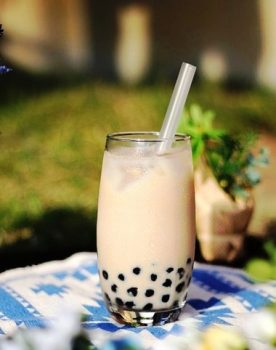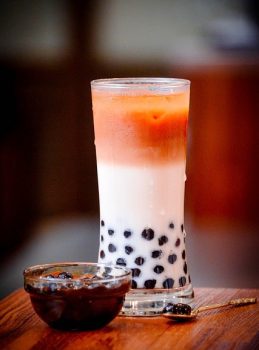The Taiwanese Bubble Tea Receives International Popularity Posted by Ayana on Dec 2, 2019 in Uncategorized
Bubble tea (珍珠奶茶 zhēn zhū nǎi chá, literally means pearl milk tea), also known as boba, is a sweet milky drink, stuffed with chewy tapioca pearls.
Boba (波霸奶茶 bō bà nǎi chá), an Asian beloved refreshment, usually consists of sweetened milk tea (奶茶 nǎi chá) and cooked tapioca pearls (珍珠粉圆 zhēn zhū fěn yuán, also known as波霸 bō bà). The tea flavor, the sweetener, the liquid, the amount of ice if added, and the color of the tapioca balls can vary. The drink is served with a spoon or a fat straw (吸管 xī guǎn) through which the pearls can be eaten. Watch the following video to see the classical bubble tea recipe:
The #Bubble tea tag on Instagram is filled with pictures of people enjoying the drink all over the world. Boba lovers share photos of their drinks from Korea to Germany, from Canada to Colombia. But the famous tea-based drink was actually invented in Taiwan (台湾 Táiwān).
One of the claimer for inventing the bubble tea is Lin Xiuhui from Chun Shui Tang Teahouse, Taichung city. In 1987, on her daily morning visit to the local market (市场 shì chǎng) to purchase fresh ingredients, Lin bought a typical Taiwanese dessert of sweetened tapioca pudding. Back in the teahouse (茶馆 chá guǎn) she blended the pudding into a milk tea. The new drink quickly outsold all of the other iced teas. Even after decades on the menu (菜单 cài dān), bubble tea makes up 80-90% of Chun Shui Tang sales.
There are two competing stories for the origin of bubble tea. About 160 kilometers south, a big sign in Han Lin Tea Room, Tainan city, reads: 珍珠奶茶创始店 (zhēn zhū nǎi chá chuàng shǐ diàn), meaning: original creator of boba milk tea. In 1986, after a visit to the local market, the restaurant owner was inspired to cook the tapioca pearls he bought and blend them into an iced tea. Later, he added brown sugar (红糖 hóng táng), creating the black tapioca.
While the origins of bubble tea are still debated, there are some health concerns raised about the popular drink. On July 2019, Singapore’s Mount Alvernia Hospital warned people that consuming too much bubble tea can increase the risk of getting a chronic disease. The high levels of calories, fat and sugar (糖 táng) are not recommended. A horrific case occurred in Zhejiang province this year, when a 14 year-old-girl was hospitalized with constipation. The scan revels hundreds of undigested tapioca balls clogging up her entire digestive system.
And yet, the drink has enjoyed a surge in popularity in recent years. The food delivery service GrabFood said that orders for bubble tea in 2018 increased 30% in the Southeast Asia region. New Yorkers stood hours in line for a boba cup at the opening of the popular Taiwanese chain Tiger Sugar this year. In Tokyo’s 23 wards over 300 stores sell the shaken beverage (饮料 yǐn liào). According to Allied Market Research, the global bubble tea market was valued at approximately 2 million dollars in 2016, and is expected to grow.
For boba fans, the pearl milk tea is not just a delicious refreshment, it’s a phenomenon. Bubble tea merchandise includes: bags, clothes, notebooks, stickers, iPhone cases, pillows and even teething toys for babies. Domino’s recently introduced a new combination to its Taiwanese market: a bubble tea-topped pizza. And a new bubble tea-themed pop-up is now open in Singapore (for two months from 19 Oct to 18 Dec).The Bubble Tea Factory is an immersive bubble tea-themed exhibition, where you’ll not only get to enjoy a free drink, you can also experience being one, at more than 10 multi-sensory installations. The next video provides a short tour in the exhibition:
Text vocabulary
Taiwan =台湾 Táiwān
Beverage = 饮料 yǐn liào
Milk tea = 奶茶 nǎi chá
Tapioca pearls = 珍珠粉圆 zhēn zhū fěn yuán
Bubble tea = 珍珠奶茶 zhēn zhū nǎi chá
Boba = 波霸奶茶 bō bà nǎi chá
Sugar = 糖 táng
Brown sugar = 红糖 hóng táng
Drinking straw = 吸管 xī guǎn
Teahouse = 茶馆 chá guǎn
Market = 市场 shì chǎng
Menu = 菜单 cài dān
To found = 创始 chuàng shǐ
好好学习,天天向上!

Build vocabulary, practice pronunciation, and more with Transparent Language Online. Available anytime, anywhere, on any device.






Leave a comment: